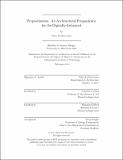Preposthuman : an architectural propaedeutic for the digitally-enhanced
Author(s)
Stevermer, Tyler Jon
DownloadFull printable version (45.07Mb)
Alternative title
Architectural propaedeutic for the digitally-enhanced
Other Contributors
Massachusetts Institute of Technology. Department of Architecture.
Advisor
Caroline A. Jones and Brandon Clifford.
Terms of use
Metadata
Show full item recordAbstract
For users to become posthuman the architectural environment must become a training apparatus, a type of propaedeutic, where our built developments simultaneously develop us. This project fashions waste, ingestion, lounging, and bathing environments as components of our posthuman training grounds. Theorists in the humanities and technology sciences envisioned this next stage in our development as becoming a type of cybernetic organism-a cyborg-in which physical and intelligence-based modifications are co-produced with machines. The recent near-ubiquity of personal internet devices and oncoming wearable technologies bring the posthuman closer, and less like science-fiction. Yet despite our advanced technology, our bodies remain legitimate. Spaces remain legitimate. Within posthumanism, singularity does not occur-we do not transcend our anatomy into some type of digital non-space. As posthumans we will use our environment and our bodies as medium, mediator, and modifier to filter, flavor, and fashion our information. Boundaries blur, consciousness becomes augmented, and architecture and the body act as symbiotic prosthetics not only for each other, but socially and ecologically. Here is a land where telepresence meshes with corporeality-where the digital is also sensorial. Automation and autonomy are no longer antonyms-and our sentience is allowed to flicker between the various realities to which it is tethered. Here, architecture serves as the suture between our digital and physical lives, creating a truly networked body from the scale of the global to the microbial. Buildings can no longer be the wire mothers of Harry F. Harlow's psychological experiments on attachment. Rather than attempting to chill occupants into humanist superiority, architecture must become the cloth mother, which we posthumans nuzzle, in order to truly connect.
Description
Thesis: M. Arch., Massachusetts Institute of Technology, Department of Architecture, 2015. This electronic version was submitted by the student author. The certified thesis is available in the Institute Archives and Special Collections. Cataloged from student-submitted PDF version of thesis. Includes bibliographical references (pages 126-129).
Date issued
2015Department
Massachusetts Institute of Technology. Department of ArchitecturePublisher
Massachusetts Institute of Technology
Keywords
Architecture.